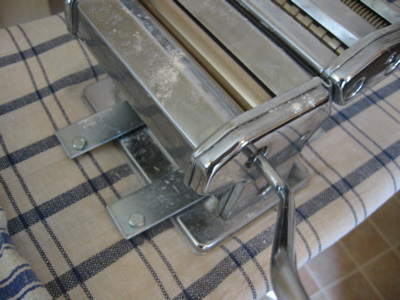Are Pasta Machines Evil?
By no means. However there are more than a few purists out there (the majority of them Italian) who turn their noses up at pastas made via mechanical rollers. What difference could that possibly make versus a rolling pin? Well, pasta dough is plastic and malleable. Porous wooden surfaces like pins and boards press a subtle, rough “cat’s tongue”-like texture onto it. Perfectly smooth stainless steel rollers don’t. So pasta made by machine feels different in the mouth.
Sure it’s a subtlety, but to someone who was raised on grandma’s hand-made pappardelle, a potentially important one. Some claim that there’s a functional difference between hand and machine-rolled pasta in that a slightly rough surface holds onto sauces a bit better. I speculate that what the rough, wooden board texture really signifies is a loving care and attention to detail that even the best machines can never deliver.
Personally, I can only go so far with the hand-rolled pasta thing. As you saw earlier in the week, I’m happy to roll dough for half an hour or so to make a pound of rustic tagliatelle. But for something like ravioli, where you need many, many uniform sheets, forget it. That’s where any dedication I might have to grandmotherly tradition breaks down utterly. So I whip out my own piece of modernity, a 20-year-old Italian-made pasta machine which, in Alton Brown style, I’ve bolted down to an old ironing board with brackets:

Actually I guess they technically call them “mending plates”, but then I don’t know much about hardware. Ironing boards being made the way they are (of metal mesh and thin foam padding), it’s easy to cut a little hole in the fabric, push a bolt through, and fasten the machine down with wing nuts and washers. It ruins a perfectly good ironing board of course, but the system holds the machine down very nicely (I’ve always hated those little “c” clamps that pasta machines come with…they always fall off), and you get a big, long dedicated surface to work on.
A pasta machine bolted to an ironing board is something of a monster as kitchen gadgets go, I’ll admit that. Something you can’t exactly tuck in a kitchen drawer. Still it stores rather well in the basement with the legs folded down, kept safe from mice inside an extra-thick contractor’s trash bag. Go ahead, call me crazy. The pasta is darn good.